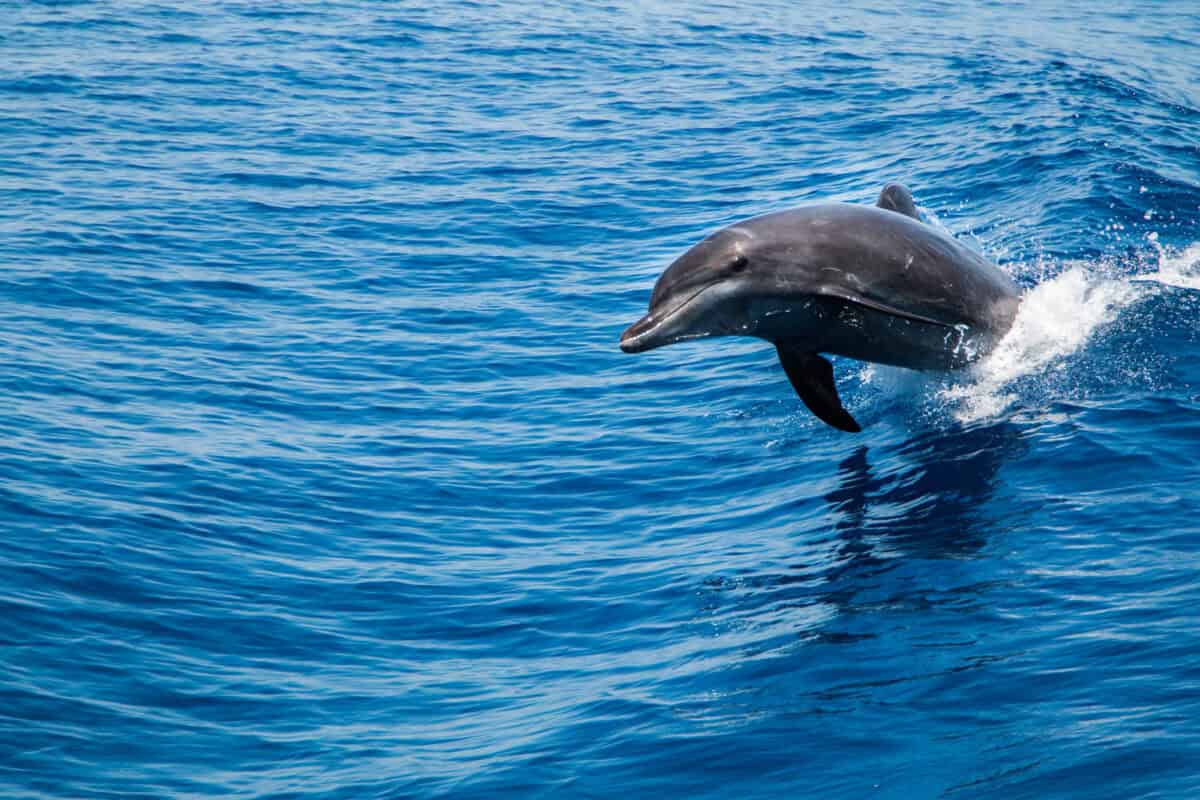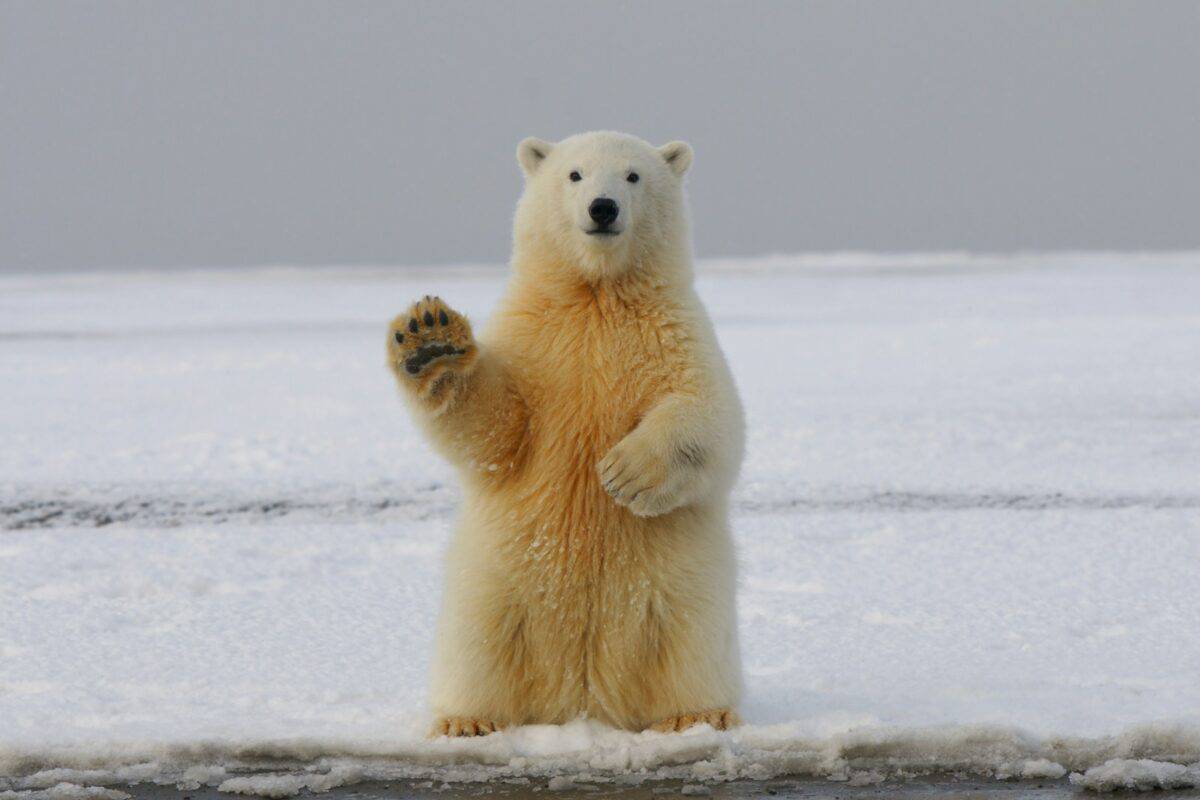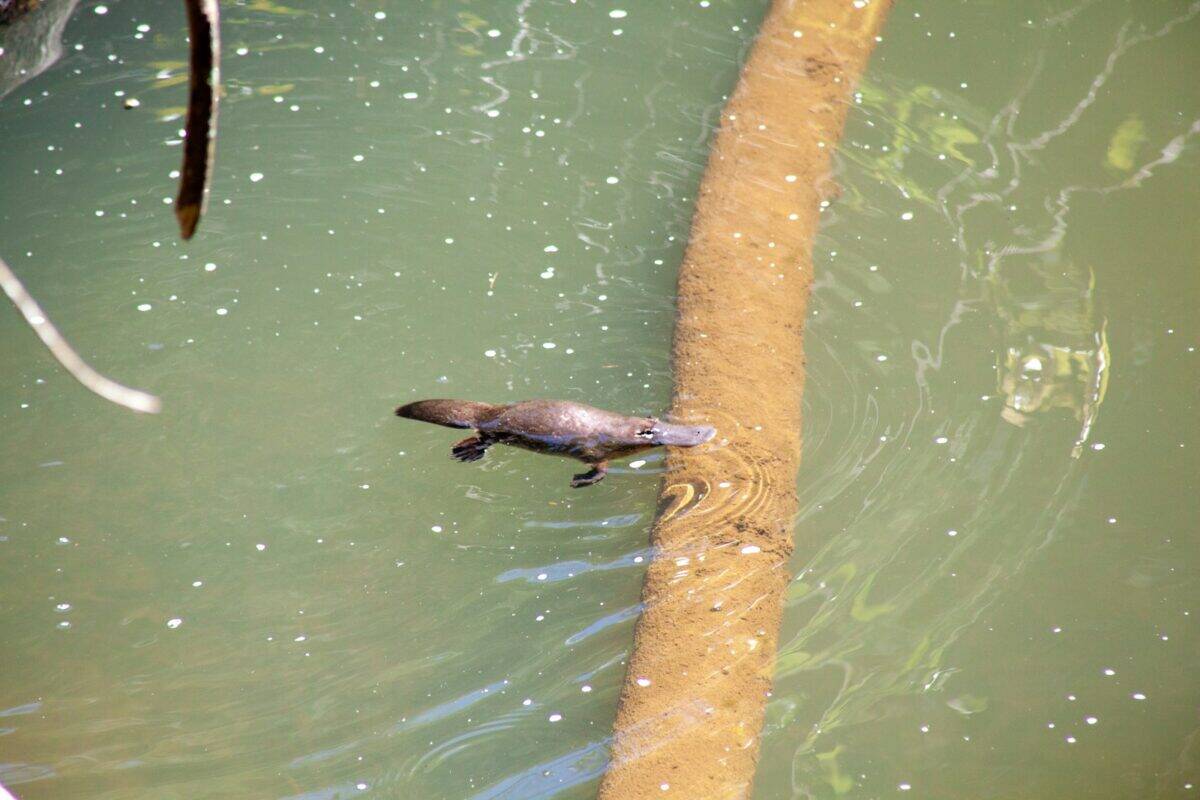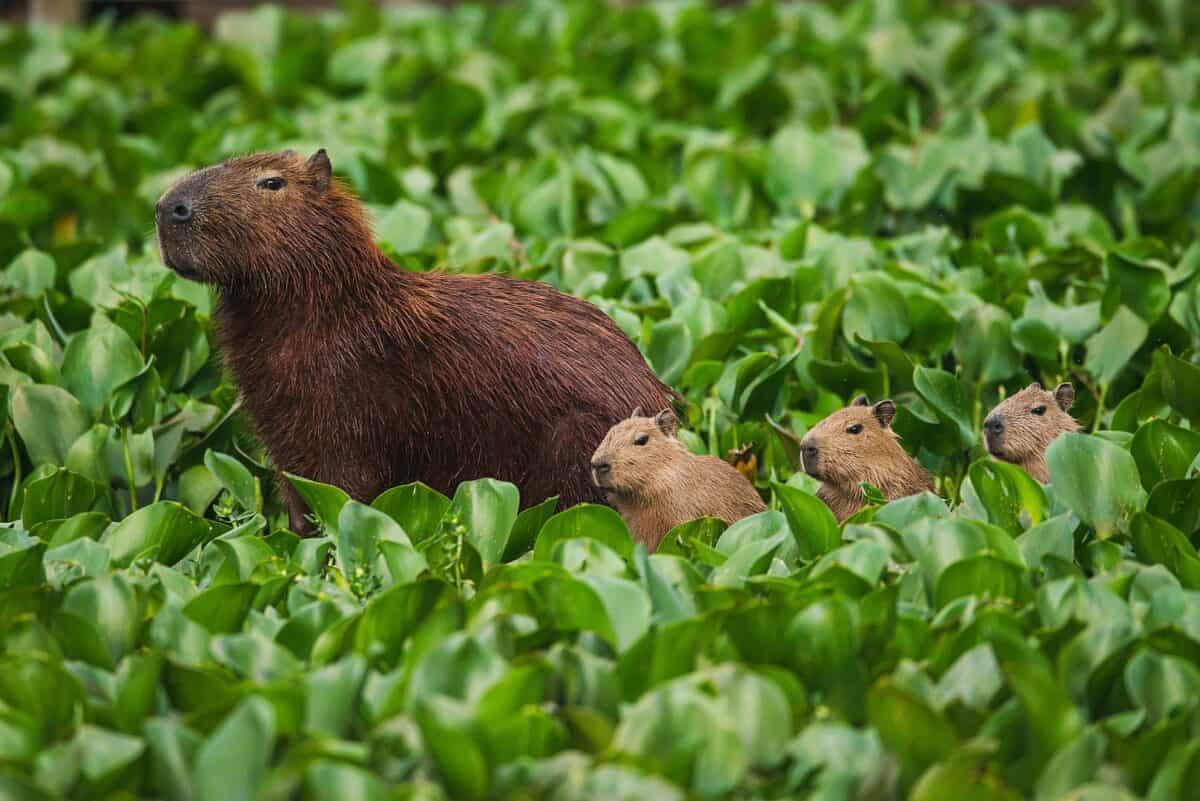Mammals are warm-blooded, vertebrate animals characterized by their hair or fur, three middle ear bones, and mammary glands in females. While most mammals live exclusively on land, a fascinating subset has evolved to thrive partially or completely in aquatic environments. These remarkable creatures have developed specialized adaptations that allow them to navigate the challenges of water-based living while maintaining the core characteristics that define mammals. From the mighty blue whale to the playful sea otter, aquatic mammals showcase nature’s incredible adaptability and evolutionary ingenuity. In this article, we’ll explore twelve diverse mammals that have made water their primary habitat, examining their unique adaptations, behaviors, and ecological roles.
11. Bottlenose Dolphins

Bottlenose dolphins (Tursiops truncatus) are among the most recognizable aquatic mammals, known for their intelligence and playful behavior. These cetaceans have streamlined, torpedo-shaped bodies that can reach lengths of 10-14 feet and weights of 300-1,400 pounds. Their smooth, rubbery skin minimizes drag in water, while a thick layer of blubber provides insulation in cold waters. Bottlenose dolphins breathe through a blowhole on top of their head and must consciously remember to surface for air, unlike humans whose breathing is automatic.
These highly social animals typically live in pods of 2-15 individuals, though larger groups may form temporarily. They communicate using a complex system of clicks, whistles, and body language. Each dolphin develops a unique signature whistle that functions like a name. Their remarkable intelligence is evident in their problem-solving abilities, use of tools, and capacity to learn human-designed communication systems. Bottlenose dolphins employ echolocation for hunting, sending out sound waves that bounce off objects and return as echoes, creating detailed “sound pictures” of their surroundings. They primarily feed on fish, squid, and crustaceans, sometimes employing cooperative hunting strategies to herd prey into tight groups for easier capture.
10. Manatees

Manatees, often called “sea cows,” are large, gentle herbivores belonging to the order Sirenia. These slow-moving mammals can grow up to 13 feet long and weigh as much as 1,300 pounds. Despite their massive size, manatees have relatively little body fat and rely on their low metabolic rate and the heat generated by their digestive processes to maintain body temperature. Their bodies are perfectly adapted for their aquatic lifestyle, with paddle-shaped flippers, a powerful flat tail for propulsion, and nostrils that close tightly underwater.
Manatees spend approximately 50% of their day sleeping, 30% navigating, and 20% feeding. They are herbivores that consume about 10-15% of their body weight daily in aquatic plants. Unlike most marine mammals, manatees can live in both saltwater and freshwater environments, though they need access to freshwater for drinking. While manatees have no natural predators, human activities pose significant threats to their survival. Boat collisions are the leading cause of manatee deaths, followed by habitat loss, entanglement in fishing gear, and water pollution. All three extant manatee species—the Amazonian, West African, and West Indian (including the Florida subspecies)—are classified as vulnerable or endangered, making conservation efforts crucial for their continued existence.
9. Sea Otters

Sea otters (Enhydra lutris) are charismatic marine mammals belonging to the weasel family. Unlike most aquatic mammals, sea otters don’t rely on a thick layer of blubber for insulation. Instead, they possess the densest fur of any animal, with up to one million hairs per square inch. This incredibly plush coat traps air bubbles that provide both insulation and buoyancy. Sea otters are relatively small compared to other marine mammals, with males reaching up to 100 pounds and females about 75 pounds. They boast flexible wrist joints, webbed hind feet, and retractable claws that help them manipulate prey items with remarkable dexterity.
Sea otters are perhaps best known for their tool use—they’re one of the few non-primate species to regularly use tools. They often carry a favorite rock in a pouch-like fold of skin under their forearm, using it to crack open hard-shelled prey like clams, mussels, and sea urchins. To maintain their high metabolic rate, sea otters consume approximately 25-30% of their body weight daily. They play a crucial ecological role as a keystone species, controlling sea urchin populations that would otherwise decimate kelp forests. These kelp ecosystems serve as carbon sinks and provide habitat for countless marine species. After being hunted to near-extinction for their fur during the maritime fur trade, sea otter populations have rebounded in some areas thanks to conservation efforts, though they remain endangered or threatened throughout much of their range.
8. Blue Whales

Blue whales (Balaenoptera musculus) hold the distinction of being the largest animals ever to have lived on Earth, surpassing even the largest dinosaurs. These magnificent marine mammals can reach lengths of up to 100 feet and weights of 200 tons—equivalent to about 33 elephants. Despite their enormous size, blue whales feed primarily on some of the ocean’s smallest creatures: krill. Using a feeding method called lunge feeding, they can consume up to 4 tons of krill daily during peak feeding season. Their massive hearts, weighing approximately 400 pounds and roughly the size of a small car, pump blood through their enormous bodies.
Blue whales are known for their deep, resonant vocalizations that can travel hundreds of miles underwater. These low-frequency sounds, often below the threshold of human hearing, are among the loudest produced by any animal. Blue whales are typically solitary or travel in pairs, though they may gather in larger numbers where food is abundant. They undertake one of the longest migrations of any mammal, traveling between cold, productive feeding grounds near the poles and warmer breeding areas closer to the equator. Despite international protection since 1966, blue whale populations remain at approximately 10-25% of their pre-whaling numbers. Climate change, ocean acidification, entanglement in fishing gear, and ship strikes continue to threaten their recovery, keeping them classified as endangered throughout their range.
7. Polar Bears

Polar bears (Ursus maritimus) occupy a unique position as both terrestrial and marine mammals. Officially classified as marine mammals due to their dependence on the ocean for food and habitat, polar bears are powerful swimmers capable of covering vast distances in frigid Arctic waters. They possess several adaptations for aquatic life, including partially webbed front paws that function as efficient paddles, water-repellent fur, and a thick layer of blubber for insulation. Their elongated bodies and relatively small heads create a streamlined profile that enhances swimming efficiency.
These apex predators primarily hunt seals, especially ringed and bearded seals, using sea ice as a platform for hunting. A polar bear will often wait patiently by a seal’s breathing hole in the ice, sometimes for hours, before striking when the seal surfaces to breathe. Their acute sense of smell allows them to detect seals under three feet of ice from nearly a mile away. Climate change poses the most significant threat to polar bear survival, as diminishing sea ice reduces their hunting grounds and forces them to swim longer distances between ice floes. The International Union for Conservation of Nature (IUCN) lists polar bears as vulnerable, with projections suggesting that two-thirds of the global population could disappear by 2050 if current warming trends continue. As the Arctic’s keystone species, their decline would have cascading effects throughout the entire ecosystem.
6. Beavers

Beavers are semi-aquatic rodents renowned for their engineering prowess and ability to transform landscapes. North America is home to the North American beaver (Castor canadensis), while Eurasia hosts the European beaver (Castor fiber). These industrious animals are perfectly adapted for their amphibious lifestyle, with water-repellent fur, transparent nictitating membranes that protect their eyes underwater, closable nostrils and ears, and large webbed hind feet. Their most distinctive feature is their broad, flat, scaly tail, which serves multiple functions: as a rudder while swimming, a prop for balance when gnawing trees, a fat storage reserve, and a warning system—beavers slap their tails loudly on water to alert colony members of potential danger.
Often described as ecosystem engineers, beavers create and maintain wetland habitats that benefit countless other species. Their dams and lodges are architectural marvels built from branches, mud, and stones. These structures create ponds that provide beavers with protection from predators and easy access to food during winter. Beaver ponds slow water flow, reducing erosion and flooding, filtering pollutants, recharging groundwater, and creating habitat diversity. A beaver’s diet consists mainly of tree bark, aquatic plants, leaves, and twigs. They have special adaptations for underwater feeding, including lips that close behind their front incisors, allowing them to gnaw wood underwater without swallowing water. After being nearly exterminated in many regions due to the fur trade, beaver populations have recovered significantly through conservation efforts and now play a vital role in watershed restoration projects.
5. Platypuses

The platypus (Ornithorhynchus anatinus) is perhaps one of the most unusual mammals on Earth, so peculiar that when European naturalists first encountered specimens, many dismissed them as elaborate hoaxes. Native to eastern Australia, these semi-aquatic mammals possess a unique combination of features: they lay eggs like reptiles, have bills resembling ducks, tails similar to beavers, and venomous spurs on their hind legs (in males). Platypuses are excellent swimmers, propelling themselves through the water with their front webbed feet while using their waterproof fur for insulation. Their beaver-like tails store fat reserves and provide steering assistance while swimming.
Platypuses hunt underwater with their eyes, ears, and nostrils closed, relying instead on electroreception—the ability to detect electrical impulses generated by the muscular contractions of their prey. Their sensitive bills contain thousands of electroreceptors and mechanoreceptors that create a detailed mental map of their surroundings even in murky water or complete darkness. While foraging, platypuses collect prey items such as insect larvae, freshwater shrimp, and crayfish in their cheek pouches, then surface to crush them using specialized grinding pads, as they lack teeth as adults. Platypuses don’t have stomachs; food passes directly from their esophagus to their intestines. Though not currently listed as endangered, platypus populations face increasing threats from habitat destruction, water pollution, drought, and predation by invasive species. Their unique evolutionary position makes their conservation particularly important for preserving biodiversity.
4. Hippopotamuses

Hippopotamuses (Hippopotamus amphibius) are massive semi-aquatic mammals native to sub-Saharan Africa. Despite their bulky appearance—males can weigh up to 3,300 pounds—hippos are surprisingly agile in water and can run at speeds up to 19 mph on land. Their barrel-shaped bodies, webbed feet, and nostrils positioned high on their snouts all facilitate their semi-aquatic lifestyle. Hippos spend up to 16 hours daily submerged in rivers or lakes, keeping cool during the African heat. They can hold their breath for up to five minutes and have a reflex that allows them to sleep underwater, automatically rising to breathe without waking.
Contrary to popular belief, hippos cannot swim or float easily due to their dense body mass. Instead, they move through water by pushing off from the bottom, creating a bouncing motion sometimes called “water walking” or “submarine walking.” Their skin secretes a reddish oily substance often described as “blood sweat,” though it’s neither blood nor sweat. This natural sunscreen protects their skin from sunburn and possibly infection. Despite being herbivores that consume up to 80 pounds of grass nightly, hippos are considered among Africa’s most dangerous animals, responsible for an estimated 500 human deaths annually. Their aggressive territorial behavior, especially from males defending water territory and females protecting calves, makes them unpredictable and dangerous. Currently classified as vulnerable due to habitat loss and poaching (for their meat, ivory tusks, and hides), hippo populations continue to decline across much of their range.
3. Capybaras

Capybaras (Hydrochoerus hydrochaeris) hold the distinction of being the world’s largest rodents, with adults weighing between 77-146 pounds and standing about 2 feet tall at the shoulder. Native to South America, these semi-aquatic mammals are perfectly adapted for life in and around water. Their partially webbed feet provide excellent swimming ability, while their eyes, ears, and nostrils are positioned high on their heads, allowing them to remain mostly submerged while staying alert to potential dangers. Capybaras can hold their breath underwater for up to five minutes and often sleep in water with just their noses exposed.
Social by nature, capybaras typically live in groups of 10-20 individuals, though groups of up to 100 have been observed during the dry season when water sources become limited. These groups are usually led by a dominant male who maintains breeding rights with the females. Capybaras are herbivores with a diet consisting primarily of grasses and aquatic plants, consuming approximately 6-8 pounds of vegetation daily. Their specialized digestive system, similar to that of horses and rabbits, allows them to extract maximum nutrition from fibrous plant material. They practice coprophagy (eating their own feces) to further extract nutrients from their food. Capybaras share a special relationship with many birds, allowing them to land on their bodies to eat ticks and other parasites—a classic example of a symbiotic relationship. While not globally endangered, capybara populations face threats from habitat loss, hunting for their meat and hides, and human encroachment on their wetland habitats.
2. Walruses

Walruses (Odobenus rosmarus) are instantly recognizable by their prominent tusks, whisker-covered snouts, and massive bodies. These pinniped mammals can weigh up to 1.5 tons (males) and 1 ton (females), making them the third largest seals after elephant seals and sea lions. Their most distinctive feature, the tusks, are actually elongated upper canine teeth that can grow up to 3 feet long and serve multiple purposes: they help haul their enormous bodies onto ice, create breathing holes in ice, defend against predators, establish social dominance, and anchor the animals in place while sleeping in water. Walruses have thick, wrinkled skin with sparse hair and a layer of blubber up to 6 inches thick that provides insulation in frigid Arctic waters.
Unlike many marine mammals that hunt visually, walruses are primarily tactile feeders. They use their sensitive whiskers (vibrissae) to detect prey on the ocean floor, then create powerful suction with their mouths to extract clams, mussels, and other invertebrates from their shells. A walrus can consume approximately 4,000-6,000 clams in a single feeding session. They’re highly social animals that gather in large groups called “herds” or “huddles” when hauled out on land or ice. These gatherings can include thousands of individuals packed tightly together for warmth and protection. Climate change poses a significant threat to walruses as diminishing sea ice forces them to haul out on land in larger numbers, increasing competition for food in smaller areas and raising mortality rates, especially for calves that risk being crushed in stampedes. Pacific walruses are currently listed as vulnerable, while Atlantic walruses are considered of special concern, with several subpopulations facing decline.
1. Dugongs

Dugongs (Dugong dugon) are serene, slow-moving marine mammals known for their peaceful presence in warm coastal waters of the Indo-Pacific, from East Africa to northern Australia. Closely related to manatees, dugongs are the only strictly marine members of the order Sirenia, never venturing into freshwater. These streamlined creatures typically grow 8 to 10 feet long and weigh between 500 and 1,100 pounds, with dolphin-like fluked tails that provide powerful propulsion through the water. Dugongs are specialized herbivores, feeding almost exclusively on seagrass, and they play a crucial ecological role in maintaining healthy seagrass beds.
Equipped with downward-facing snouts and bristled upper lips, dugongs graze by uprooting seagrass meadows, often leaving visible feeding trails along the ocean floor. Despite their large size, they are elusive and shy, usually seen alone or in small groups. Dugongs are long-lived, with lifespans exceeding 70 years in some cases, but they reproduce slowly—females give birth to a single calf after a gestation period of about 13 months. Like many marine mammals, dugongs face numerous threats, including habitat degradation, boat collisions, entanglement in fishing gear, and pollution. As a result, they are classified as vulnerable, with some regional populations critically endangered. Their decline serves as a signal of broader ecosystem stress, making their protection vital for the conservation of coastal marine habitats.
Conclusion:

In conclusion, the diverse array of aquatic and semi-aquatic mammals highlighted in this article underscores the extraordinary adaptability of life in response to environmental pressures. Despite their varied sizes, diets, and behaviors, all these mammals retain the defining characteristics of their class—such as mammary glands, vertebrate structures, and warm-blooded physiology—while exhibiting remarkable adaptations to aquatic environments. From the echolocating bottlenose dolphin to the electro-sensing platypus and the engineering prowess of the beaver, each species exemplifies a unique evolutionary solution to the challenges of life in or around water. These adaptations not only illustrate the versatility of mammals but also highlight the intricate balance of ecosystems where they play critical roles. As many of these species face increasing threats from climate change, habitat loss, and human activity, their conservation becomes not just a matter of protecting individual animals but of preserving the delicate ecological webs they help sustain.
- The Most Elusive Big Cats Roaming the American Southwest - August 20, 2025
- 13 Animals That Use Tools to Hunt - August 20, 2025
- 14 Creatures That Don not Need Eyes - August 20, 2025

